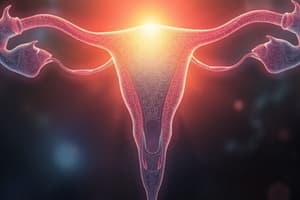Podcast
Questions and Answers
What is polymenorrhea and how does it differ from normal menstrual cycles?
What is polymenorrhea and how does it differ from normal menstrual cycles?
Polymenorrhea is characterized by abnormally frequent menses occurring at intervals less than 21 days. In contrast, normal menstrual cycles typically range from 21 to 35 days.
Define menorrhagia and state its volume criteria.
Define menorrhagia and state its volume criteria.
Menorrhagia is defined as excessive menstrual bleeding, typically over 80 ml, and/or prolonged menses lasting more than 7 days at normal intervals. This condition is cyclic in nature.
What distinguishes metrorrhagia from other types of abnormal uterine bleeding?
What distinguishes metrorrhagia from other types of abnormal uterine bleeding?
Metrorrhagia involves irregular episodes of uterine bleeding that are acyclic, meaning they do not follow the regular menstrual cycle. This differentiates it from cyclical uterine bleeding patterns.
List two systemic disorders that can lead to abnormal uterine bleeding.
List two systemic disorders that can lead to abnormal uterine bleeding.
Explain what iatrogenic causes of abnormal uterine bleeding can include.
Explain what iatrogenic causes of abnormal uterine bleeding can include.
What is the effect of increased prostaglandin E2 relative to PGF2α on fibrinolytic activity in the endometrium?
What is the effect of increased prostaglandin E2 relative to PGF2α on fibrinolytic activity in the endometrium?
How does prolonged estrogen without progesterone contribute to endometrial hyperplasia?
How does prolonged estrogen without progesterone contribute to endometrial hyperplasia?
What role does estrogen play in the pituitary gland's feedback mechanism during cystic glandular hyperplasia?
What role does estrogen play in the pituitary gland's feedback mechanism during cystic glandular hyperplasia?
What are the expected characteristics of bleeding associated with decreased estrogen levels?
What are the expected characteristics of bleeding associated with decreased estrogen levels?
Explain the relationship between amenorrhea and prolonged estrogen action in the context of cystic glandular hyperplasia.
Explain the relationship between amenorrhea and prolonged estrogen action in the context of cystic glandular hyperplasia.
What is oligomenorrhea and how is it defined in terms of menstrual cycle length?
What is oligomenorrhea and how is it defined in terms of menstrual cycle length?
At what average age does menarche typically occur?
At what average age does menarche typically occur?
Describe the changes that occur during perimenopause and the average age range for this phase.
Describe the changes that occur during perimenopause and the average age range for this phase.
What are some common contraceptive methods mentioned, and which ones are classified as hormonal?
What are some common contraceptive methods mentioned, and which ones are classified as hormonal?
What is menorrhagia and how is it characterized in terms of menstrual flow?
What is menorrhagia and how is it characterized in terms of menstrual flow?
What demographic is most commonly associated with the growth of endometrial blood supply?
What demographic is most commonly associated with the growth of endometrial blood supply?
What age range does the term 'between menarche and menopause' refer to?
What age range does the term 'between menarche and menopause' refer to?
What symptom might a female in this demographic complain of regarding endometrial health?
What symptom might a female in this demographic complain of regarding endometrial health?
Why is obesity a significant factor in understanding endometrial blood supply?
Why is obesity a significant factor in understanding endometrial blood supply?
How might the growth of endometrial blood supply impact a woman's health?
How might the growth of endometrial blood supply impact a woman's health?
What is the role of cervical cytology in diagnosing abnormal uterine bleeding?
What is the role of cervical cytology in diagnosing abnormal uterine bleeding?
How is treatment for abnormal uterine bleeding determined?
How is treatment for abnormal uterine bleeding determined?
What is the significance of the HVS in conjunction with cervical cytology?
What is the significance of the HVS in conjunction with cervical cytology?
What does 'endometrial treatment' refer to in the context of abnormal uterine bleeding?
What does 'endometrial treatment' refer to in the context of abnormal uterine bleeding?
Why is it important to differentiate between various causes of V in the context of diagnosis?
Why is it important to differentiate between various causes of V in the context of diagnosis?
Flashcards are hidden until you start studying
Study Notes
Abnormal Bleeding Patterns
- Polymenorrhea (epimenorrhea): Menstrual cycles shorter than 21 days.
- Menorrhagia (hypermenorrhea): Heavy menstrual flow (over 80 ml) lasting more than 7 days, with regular cycles.
- Metrorrhagia: Irregular bleeding between periods.
- Polymenorrhagia: Excessive and frequent menstrual bleeding, occurring in cycles.
- Menometrorrhagia: Heavy and irregular menstrual bleeding.
Causes of Abnormal Uterine Bleeding
- Genital tract (Local Causes): Trauma, infections, tumors, polyps, and other abnormalities in the reproductive organs.
- Psychological Causes: Stress, anxiety, and depression.
- Systemic Disorders: Hepatic diseases, thyroid disorders, hypertension, blood dyscrasias, pregnancy, ectopic pregnancy, and hormonal imbalances.
- Iatrogenic: Side effects of medications like oral contraceptives, progestins, injectable steroids, aspirin, heparin, warfarin, tamoxifen, and intrauterine devices.
Oligomenorrhea & Hypomenorrhea
- Menstrual cycles shorter than 3 days or longer than 35 days.
Menopause & Postmenopausal Bleeding
- Menopause: The cessation of menstruation.
- Postmenopausal Bleeding: Any bleeding from the vagina after menopause.
- Perimenopause: The transition period leading up to menopause, typically starting around age 40.
Heavy Periods (Menorrhagia)
- Prostaglandin imbalances can contribute to heavy bleeding due to vasodilation and contraction of blood vessels.
- Increased fibrinolytic activity in the endometrium can lead to bleeding.
Cystic Glandular Hyperplasia
- Excess estrogen production without feedback inhibition from the pituitary gland leads to continued FSH secretion and high estrogen levels.
- This can cause endometrial hyperplasia and heavy, prolonged, irregular bleeding due to declining estrogen levels.
Female Presentation
- When a woman presents with abnormal uterine bleeding, important elements of the medical history include age, menstrual history, medication history, and any past relevant diagnoses.
- Diagnostic procedures may include cervical cytology (Pap smear and HPV testing) and endometrial biopsy.
Treatment
- Treatment for abnormal uterine bleeding depends on the underlying cause.
Studying That Suits You
Use AI to generate personalized quizzes and flashcards to suit your learning preferences.




